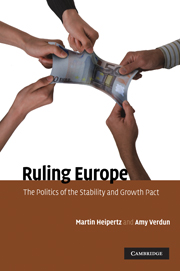Book contents
- Frontmatter
- Contents
- List of tables
- Foreword by Jean-Claude Juncker, Prime Minister of Luxembourg and President of the Eurogroup
- Preface
- Acknowledgements
- List of abbreviations
- 1 The politics of the Stability and Growth Pact
- Part I
- Part II
- 6 Implementation of the SGP in good and in bad times
- 7 From bad times to crisis
- 8 The SGP before the European Court of Justice
- 9 The SGP in times of financial turbulence and economic crisis
- 10 Conclusion: The past, present and future of the SGP and implications for European integration theory
- Appendix
- Bibliography
- Index
7 - From bad times to crisis
Published online by Cambridge University Press: 06 July 2010
- Frontmatter
- Contents
- List of tables
- Foreword by Jean-Claude Juncker, Prime Minister of Luxembourg and President of the Eurogroup
- Preface
- Acknowledgements
- List of abbreviations
- 1 The politics of the Stability and Growth Pact
- Part I
- Part II
- 6 Implementation of the SGP in good and in bad times
- 7 From bad times to crisis
- 8 The SGP before the European Court of Justice
- 9 The SGP in times of financial turbulence and economic crisis
- 10 Conclusion: The past, present and future of the SGP and implications for European integration theory
- Appendix
- Bibliography
- Index
Summary
This chapter deals with the SGP crisis of 25 November 2003 and the period running up to that dramatic ECOFIN Council. It contains two main sections. The first offers an account of the events; the second an analysis drawing on a composite version of our methodological apparatus, in particular the domestic and intergovernmental approaches with some ingredients of the other two perspectives.
The initiation of EDPs
In April 2002, a centre-right coalition came into power in Portugal. The new government under José Manuel Durão Barroso not only accepted the Commission's critical stance on the budgetary situation but, stating that the socialists had ‘left the country in rags’, Barroso went a step further and asked the nation to ‘make a patriotic effort to save’. The 2002 budget was revised and austerity measures were adopted, including a 2 per cent increase of the VAT rate and a postponement of planned corporate tax cuts besides efforts to reduce public expenditure. Barroso successfully employed the SGP framework and accepted in particular the placing of his fiscal policies under the EDP regime. Portugal was the first country to be found in excessive deficit in 2003 and its government used the SGP as an external constraint for making the consolidation course domestically acceptable (see below). This strategy implied close cooperation between the government and the Commission.
- Type
- Chapter
- Information
- Ruling EuropeThe Politics of the Stability and Growth Pact, pp. 128 - 153Publisher: Cambridge University PressPrint publication year: 2010



